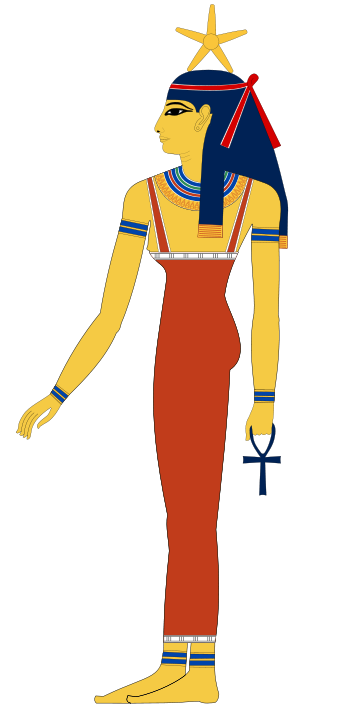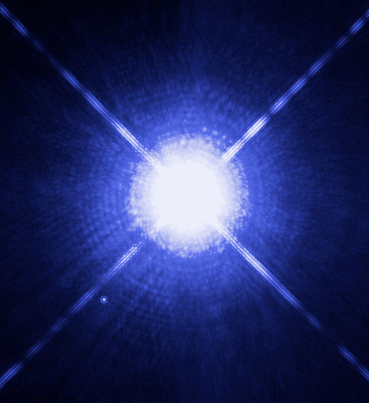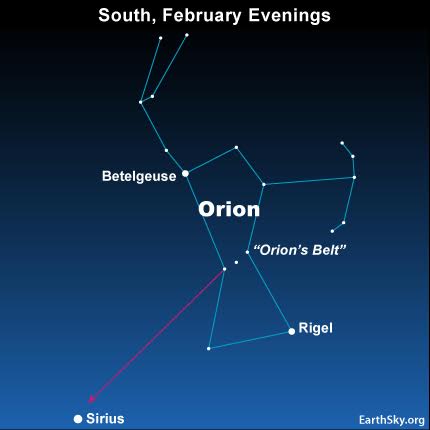Jim Livingstone in Custer, South Dakota wrote on February 19, 2018: “I was surprised to see the rainbow of colors in the radial arms of Sirius.”
The brightest star visible from any part of Earth is Sirius in the constellation Canis Major the Greater Dog. Sirius is sometimes called the Dog Star. Most people in the Northern Hemisphere notice Sirius in the southeast – south – or southwest on evenings from winter to mid-spring. February evenings are a grand time to see it. It’s also fun to spot Sirius as it ascends in the east before dawn on late summer mornings.
Although white to blue white in color, Sirius might be called a rainbow star, as it often flickers with many colors.
View larger. | Amanda Cross in the U.K. caught these images of Sirius on December 11, 2017. She wrote: “The color flashes are picked up by the camera as the atmosphere splits the light from the star. No color enhancements were made to this image. This is how the camera picked up the colors.” Read more.
The brightness, twinkling and color changes sometimes prompt people to report Sirius as a UFO!
In fact, these changes are simply what happens when such a bright star as Sirius shines through the blanket of Earth’s atmosphere. The varying density and temperature of Earth’s air affect starlight, especially when we’re seeing the star low in the sky.
The shimmering and color changes happen for other stars, too, but these effects are more noticeable for Sirius because Sirius is so bright.
2018 is the Year of the Dog in China. This photo – by Matthew Chin in Hong Kong – shows Canis Major the Greater Dog and its brightest star Sirius.
From the mid-northern latitudes such as most of the U.S., Sirius rises in the southeast, arcs across the southern sky, and sets in the southwest. From the Southern Hemisphere, Sirius arcs high overhead.
As seen from around the world, Sirius rises in mid-evening in December. By mid-April, Sirius is setting in the southwest in mid-evening.
Sirius is always easy to find. It’s the sky’s brightest star! Plus, anyone familiar with the constellation Orion can simply draw a line through Orion’s Belt to find this star. Sirius is roughly 8 times as far from the Belt as the Belt is wide.
Sirius is well known as the Dog Star, because it’s the chief star in the constellation Canis Major, the Big Dog. Have you ever heard anyone speak of the dog days of summer? Sirius is behind the sun as seen from Earth in Northern Hemisphere summer. In late summer, it appears in the east before sunrise – near the sun in our sky. The early stargazers might have imagined the double-whammy of Sirius and the sun caused the hot weather, or dog days.
In ancient Egypt, the name Sirius signified its nature as scorching or sparkling. The star was associated with the Egyptian gods Osiris, Sopdet and other gods. Ancient Egyptians noted that Sirius rose just before the sun each year immediately prior to the annual flooding of the Nile River. Although the floods could bring destruction, they also brought new soil and new life. Osiris was an Egyptian god of life, death, fertility and rebirth of plant life along the Nile. Sopdet – which might have an even closer association with the star Sirius – began as an agricultural deity in Egypt, also closely associated with the Nile. The Egyptian new year was celebrated with a festival known as The Coming of Sopdet.
In India, Sirius is sometimes known as Svana, the dog of Prince Yudhistira. The prince and his four brothers, along with Svana, set out on a long and arduous journey to find the kingdom of heaven. However, one by one the brothers all abandoned the search until only Yudhistira and his dog, Svana, were left. At long last they came to the gates of heaven. The gatekeeper, Lord Indra, welcomed the prince but denied Svana entrance. Yudhistira was aghast and told Lord Indra that he could not forsake his good and faithful servant and friend. His brothers, Yudhistira told the Lord, had abandoned the journey to heaven to follow their hearts’ desires. But Svana, who had given his heart freely, chose to follow none but Yudhistira. The prince told the Lord that without his dog, he would forsake even heaven. This is what Lord Indra had wanted to hear, and then he welcomed both the prince and the dog through the gates of heaven.

Sopdet, the ancient Egyptian personification of the star Sirius. Image via Jeff Dahl/ Wikimedia Commons.
Astronomers express the brightness of stars in terms of stellar magnitude. The smaller the number, the brighter the star.
The visual magnitude of Sirius is -1.44, lower – brighter – than any other star. It is 3.5 times brighter than Arcturus in Bootes, the next brightest star easily visible from the northern hemisphere. There are brighter stars in terms of actual energy and light output, but they are farther away and hence intrinsically dimmer.
Normally, the only objects that outshine Sirius in our heavens are the sun, moon, Venus, Jupiter, Mars and Mercury (and usually Sirius outshines Mercury, too).
Even from big cities, you can see Sirius, the sky’s brightest star. Gowrishankar Lakshminarayanan in New York City created this composite image on December 26, 2017 and wrote: “Here you can see the brightest star of the winter night sky – Sirius – and its path as it rises in the southeast sky to clip the spire of the Freedom Tower. This is a 78-image composite, spaced 30 seconds apart. “
The next-brightest star after Sirius is Canopus. It can be seen from latitudes like that in the southern U.S. The closest major star is Alpha Centauri. It’s too far south in the sky to see easily from mid-north latitudes.
At 8.6 light-years distance, Sirius is one of the nearest stars to us after the sun. A light-year, by the way, is nearly 6 trillion miles!
Sirius is classified by astronomers as an “A” type star. That means it’s a much hotter star than our sun; its surface temperature is about 17,000 degrees Fahrenheit in contrast to our sun’s 10,000 degrees F. With slightly more than twice the mass of the sun and just less than twice its diameter, Sirius still puts out 26 times as much energy. It’s a main-sequence star, meaning it produces most of its energy by converting hydrogen into helium through nuclear fusion.
Sirius has a small, faint companion star appropriately called The Pup. That name signifies youth, but in fact the companion to Sirius is a dead star called a white dwarf. Once a mighty star, The Pup today is an Earth-sized ember, too faint to be seen without a telescope.

This Hubble Space Telescope image shows Sirius A, the brightest star in our night sky, along with Sirius B – aka The Pup – its faint, tiny stellar companion. Sirius B is the faint, tiny dot at the lower left. Image via H. Bond (STScI) and M. Barstow (University of Leicester)
The position of Sirius is RA: 06h 45m 08.9s, dec:-16° 42′ 58″.
Bottom line: Sirius is the Dog Star and the brightest star visible in Earth’s sky.
Enjoying EarthSky? Sign up for our free daily newsletter today!
from EarthSky http://ift.tt/1va0C1U
Jim Livingstone in Custer, South Dakota wrote on February 19, 2018: “I was surprised to see the rainbow of colors in the radial arms of Sirius.”
The brightest star visible from any part of Earth is Sirius in the constellation Canis Major the Greater Dog. Sirius is sometimes called the Dog Star. Most people in the Northern Hemisphere notice Sirius in the southeast – south – or southwest on evenings from winter to mid-spring. February evenings are a grand time to see it. It’s also fun to spot Sirius as it ascends in the east before dawn on late summer mornings.
Although white to blue white in color, Sirius might be called a rainbow star, as it often flickers with many colors.
View larger. | Amanda Cross in the U.K. caught these images of Sirius on December 11, 2017. She wrote: “The color flashes are picked up by the camera as the atmosphere splits the light from the star. No color enhancements were made to this image. This is how the camera picked up the colors.” Read more.
The brightness, twinkling and color changes sometimes prompt people to report Sirius as a UFO!
In fact, these changes are simply what happens when such a bright star as Sirius shines through the blanket of Earth’s atmosphere. The varying density and temperature of Earth’s air affect starlight, especially when we’re seeing the star low in the sky.
The shimmering and color changes happen for other stars, too, but these effects are more noticeable for Sirius because Sirius is so bright.
2018 is the Year of the Dog in China. This photo – by Matthew Chin in Hong Kong – shows Canis Major the Greater Dog and its brightest star Sirius.
From the mid-northern latitudes such as most of the U.S., Sirius rises in the southeast, arcs across the southern sky, and sets in the southwest. From the Southern Hemisphere, Sirius arcs high overhead.
As seen from around the world, Sirius rises in mid-evening in December. By mid-April, Sirius is setting in the southwest in mid-evening.
Sirius is always easy to find. It’s the sky’s brightest star! Plus, anyone familiar with the constellation Orion can simply draw a line through Orion’s Belt to find this star. Sirius is roughly 8 times as far from the Belt as the Belt is wide.
Sirius is well known as the Dog Star, because it’s the chief star in the constellation Canis Major, the Big Dog. Have you ever heard anyone speak of the dog days of summer? Sirius is behind the sun as seen from Earth in Northern Hemisphere summer. In late summer, it appears in the east before sunrise – near the sun in our sky. The early stargazers might have imagined the double-whammy of Sirius and the sun caused the hot weather, or dog days.
In ancient Egypt, the name Sirius signified its nature as scorching or sparkling. The star was associated with the Egyptian gods Osiris, Sopdet and other gods. Ancient Egyptians noted that Sirius rose just before the sun each year immediately prior to the annual flooding of the Nile River. Although the floods could bring destruction, they also brought new soil and new life. Osiris was an Egyptian god of life, death, fertility and rebirth of plant life along the Nile. Sopdet – which might have an even closer association with the star Sirius – began as an agricultural deity in Egypt, also closely associated with the Nile. The Egyptian new year was celebrated with a festival known as The Coming of Sopdet.
In India, Sirius is sometimes known as Svana, the dog of Prince Yudhistira. The prince and his four brothers, along with Svana, set out on a long and arduous journey to find the kingdom of heaven. However, one by one the brothers all abandoned the search until only Yudhistira and his dog, Svana, were left. At long last they came to the gates of heaven. The gatekeeper, Lord Indra, welcomed the prince but denied Svana entrance. Yudhistira was aghast and told Lord Indra that he could not forsake his good and faithful servant and friend. His brothers, Yudhistira told the Lord, had abandoned the journey to heaven to follow their hearts’ desires. But Svana, who had given his heart freely, chose to follow none but Yudhistira. The prince told the Lord that without his dog, he would forsake even heaven. This is what Lord Indra had wanted to hear, and then he welcomed both the prince and the dog through the gates of heaven.

Sopdet, the ancient Egyptian personification of the star Sirius. Image via Jeff Dahl/ Wikimedia Commons.
Astronomers express the brightness of stars in terms of stellar magnitude. The smaller the number, the brighter the star.
The visual magnitude of Sirius is -1.44, lower – brighter – than any other star. It is 3.5 times brighter than Arcturus in Bootes, the next brightest star easily visible from the northern hemisphere. There are brighter stars in terms of actual energy and light output, but they are farther away and hence intrinsically dimmer.
Normally, the only objects that outshine Sirius in our heavens are the sun, moon, Venus, Jupiter, Mars and Mercury (and usually Sirius outshines Mercury, too).
Even from big cities, you can see Sirius, the sky’s brightest star. Gowrishankar Lakshminarayanan in New York City created this composite image on December 26, 2017 and wrote: “Here you can see the brightest star of the winter night sky – Sirius – and its path as it rises in the southeast sky to clip the spire of the Freedom Tower. This is a 78-image composite, spaced 30 seconds apart. “
The next-brightest star after Sirius is Canopus. It can be seen from latitudes like that in the southern U.S. The closest major star is Alpha Centauri. It’s too far south in the sky to see easily from mid-north latitudes.
At 8.6 light-years distance, Sirius is one of the nearest stars to us after the sun. A light-year, by the way, is nearly 6 trillion miles!
Sirius is classified by astronomers as an “A” type star. That means it’s a much hotter star than our sun; its surface temperature is about 17,000 degrees Fahrenheit in contrast to our sun’s 10,000 degrees F. With slightly more than twice the mass of the sun and just less than twice its diameter, Sirius still puts out 26 times as much energy. It’s a main-sequence star, meaning it produces most of its energy by converting hydrogen into helium through nuclear fusion.
Sirius has a small, faint companion star appropriately called The Pup. That name signifies youth, but in fact the companion to Sirius is a dead star called a white dwarf. Once a mighty star, The Pup today is an Earth-sized ember, too faint to be seen without a telescope.

This Hubble Space Telescope image shows Sirius A, the brightest star in our night sky, along with Sirius B – aka The Pup – its faint, tiny stellar companion. Sirius B is the faint, tiny dot at the lower left. Image via H. Bond (STScI) and M. Barstow (University of Leicester)
The position of Sirius is RA: 06h 45m 08.9s, dec:-16° 42′ 58″.
Bottom line: Sirius is the Dog Star and the brightest star visible in Earth’s sky.
Enjoying EarthSky? Sign up for our free daily newsletter today!
from EarthSky http://ift.tt/1va0C1U


Aucun commentaire:
Enregistrer un commentaire